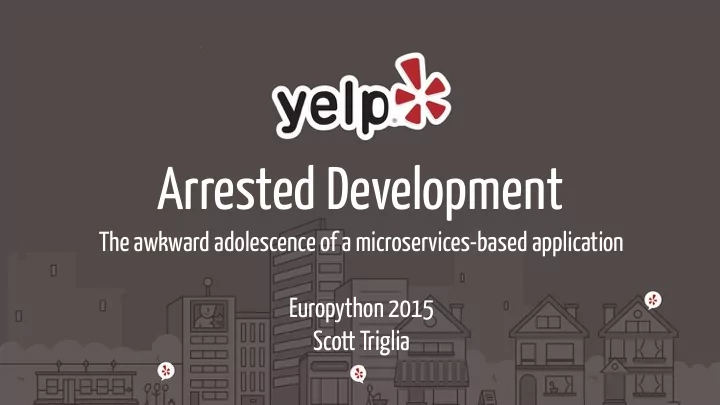

Arrested Development The awkward adolescence of a microservices-based application Europython 2015 Scott Triglia
The Company
77M reviews 142M monthly unique users
Scott Triglia @scott_triglia 4 years with Yelp Your Speaker Search, ML, Services
Yelp Transaction The Product Platform
Yelp Transaction The Product Platform (or just “Platform”)
Microservices That Hot Trend
“…an approach to developing a single application as a suite of small services, each running in its own process and communicating with lightweight mechanisms…” http://martinfowler.com/articles/microservices.html
(clarkmaxwell via Flickr; CC BY-NC-ND 2.0)
Monolithic python code resisted decoupling
Monolithic python code catered to the lowest common denominator
Monolithic python code was anti-agile
Services Time
Pinterest Gingerbread House
Pinterest Gingerbread House
API complexity increases
coupling rises
interactions get murky
process does not scale
So what’s an engineer to do?
• Decoupling • Defining • Understanding Production • Staying Agile
• Decoupling • Defining • Understanding Production • Staying Agile
Old boring problem Monolithic spaghetti code
Solution: microservices!
New exciting problem how to share concepts across services
New exciting problem distributed tech debt
service_type
service_type What product does your business provide and how do they provide it?
service_type pickup delivery
booking_at_customer service_type pickup booking_at_business delivery
booking_at_customer service_type hotel_reservation goods_at_business pickup booking_at_business goods_at_customer delivery
Confusing Pervasive Convenient, but not designed
Draw boundaries, introduce domain-specific concepts tied to functionality
Lessons
Interfaces are the sum of APIs, shared libraries, and the data that flows through them
Sacrificing DRYness can be the best choice for overall design
Service interfaces are a great opportunity to intentionally decouple systems
• Decoupling • Defining • Understanding Production • Staying Agile
Have you ever needed to understand a system and been told go read the source?
What about a system which only validates half its interface?
Coming from a python monolith, strong interfaces were quite rare
def checkout(order, price, **kwargs): “““Process an order.””” validate_order(order) charge_credit_card(order.user, price) notify_user(order, **kwargs)
Client side - Yelp/bravado from bravado.client import SwaggerClient client = SwaggerClient.from_url( “www.myservice.com/swagger.json” ) pet = client.pet.getPetById(petId=42).result()
Server side - striglia/pyramid_swagger # In your Pyramid webapp.py config.include(‘pyramid_swagger')
Lessons
Interfaces should be intentional
Interfaces should be explicit
Find the mechanical things which don’t scale and automate them mercilessly
• Decoupling • Defining • Understanding Production • Staying Agile
Real customer bug report: “We’re seeing 504s talking to the /user_info API”
Ancient times: Use logic and whatever logs happen to exist
(drbethsnow via Flickr; CC BY-NC-ND 2.0)
Better: Log all incoming API requests to any service
(spam via Flickr; CC by 2.0)
Best: Every service has a detailed access/ error log and tooling to examine them
So what about that customer with the mystery 504?
2.5 s 0.15 s
Realistically: Don’t require the customer to report issues in the first place
es_host: elasticsearch-hostname es_port: 14900 index: logstash-errors-%G.%V type: frequency num_events: 20 timeframe: minutes: 2 alert: - "modules.sensu_alert.SensuAlerter" sensu: team: platform tip: "This alert indicates a large number of errors across the Platform product. See <link to Kibana> for details." page: true status: 2 # CRITICAL
es_host: elasticsearch-hostname es_port: 14900 index: logstash-errors-%G.%V type: frequency num_events: 20 timeframe: minutes: 2 alert: - "modules.sensu_alert.SensuAlerter" sensu: team: platform tip: "This alert indicates a large number of errors across the Platform product. See <link to Kibana> for details." page: true status: 2 # CRITICAL
es_host: elasticsearch-hostname es_port: 14900 index: logstash-errors-%G.%V type: frequency num_events: 20 timeframe: minutes: 2 alert: - "modules.sensu_alert.SensuAlerter" sensu: team: platform tip: "This alert indicates a large number of errors across the Platform product. See <link to Kibana> for details." page: true status: 2 # CRITICAL
Lessons
Logging is a superpower. Use it wisely constantly.
But raw data is not enough! Visualize and monitor actively.
These approaches make a world of difference: • Incident response from days to minutes • Investigations from ∞ to minutes
• Decoupling • Defining • Understanding Production • Staying Agile
Uncomfortable conversation: “Customers had their orders interrupted. How are you preventing it going forward?”
Understandable response: “Deploy more carefully”
Understandable response: “Expand oncall”
How do we ensure the team stays agile as our services grow in complexity?
Pain point: The testing environment is {broken, flaky, not like prod}
Pain point: Tests passed but production broke
Production monitoring is the natural extension of excellent pre-deploy testing.
Pain point: No clue how much time we spend fixing production issues
Pain point: Tough to argue what changes will make things more robust
And as with everything else, this must eventually be automated
Lessons
Recommend
More recommend